
Joe Biden, George Floyd and #BLM: how Biden won the race for presidency.
In this article, I will analyze how Joe Biden used George Floyd's death and the consequent rise of the Black Lives Matter movement to win over black voters during the run-up to the 2020 presidential elections. I will conduct a discourse analysis of Biden’s tweets that mention George Floyd. Before starting this analysis, I will discuss some important background information on Floyd's death, racism in America, and the rise of the Black Lives Matter movement.
George Floyd: what happened?
George Floyd's death on May 25th, 2020, cannot have escaped your notice. Floyd, a 46 year old Black man, was killed by police. After allegedly trying to pay with a counterfeit bill, Floyd was arrested by four white police officers in Minneapolis. During his arrest, one of the police officers knelt on Floyd’s neck for over eight minutes while he was already handcuffed and on the ground. Despite Floyd’s complaints about being unable to breathe, the officer refused to lift his knee from Floyd’s neck. After his death, two autopsies revealed that Floyd’s death was a result of the neck and back compression enforced by the police officers.
As a result of Floyd’s death, worldwide protests against racism and excessive police violence erupted. A day after his death, hundreds of people marched towards the Minneapolis Police while carrying posters and signs with phrases such as “I can’t breathe” and “Black Lives Matter.” In the following days, weeks and even months, numerous American cities went through a period of peaceful protests as well as violent riots. Statues and monuments associated with racism or slavery were destroyed, businesses vandalized and riots were violently struck down by police. Due to the extent of the protests, the #BLM movement received worldwide attention and the debate on contemporary racism in tensified.
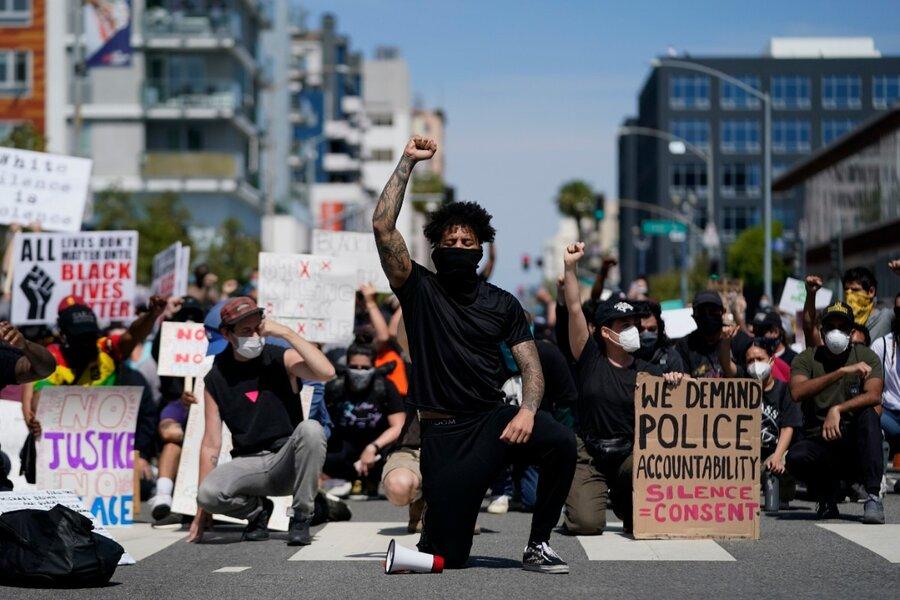
Black Lives Matter protests after Floyd's death
Contemporary racism in America
The debate on racism is not something that Americans are unfamiliar with - racism towards black people has been around for hundreds of years. During the Atlantic slave trade, almost half a million Africans were transported to what is now called the United States to serve as slaves for white elite (Eltis, 2008). As a result, slavery became racialized by a system based on African ancestry and skin color (Wood, 2003). From this time onwards, the social groups of us (white Americans) and them (black Afro-Americans) were constructed and kept alive.
As Balibar (2007) discusses, racism is a social phenomenon that inscribes itself in practices, discourses and representations. The practices of violence, humiliation and exploitation of Black Americans, the discourse of us versus them, and the promotion of segregation to preserve ‘America’s true identity’ have all contributed to contemporary racism against Afro-Americans.
Although slavery was formally abolished in 1865, the consequences of it are still apparent today. The complete destruction of racism would require the revolt of its victims, the transformation of racists themselves, and even the dissolution of the community in which racism was first created (Balibar, 2007).
The media environment and #BLM
One step in this process towards a world free of racism is the revolt of racism’s victims. However, not every act of revolt has received as much attention as the protests and riots following George Floyd’s death. A major reason behind the enormous attention received by the #BLM movementis the contemporary news media environment.
The structure of this environment enables new political opportunities for protest organizations, activists, and their supporters to communicate independently of mainstream news media. They allow everyone with access to digital media to spread their ideas and call for action. Although mainstream media are still important producers of ideas and ideologies, digital media like Facebook and Twitter have acquired a more prominent position.
A consequence of this is the development of 'citizen journalism'. Citizen journalism is when ordinary people caught up in extraordinary events feel compelled to adopt the role of professional news reporter (Greer & Mc Laughlin, 2010). Nowadays, almost everyone is equipped with a device that allows them to record and upload content to the internet. From there, this content can be picked up by other users and disseminated virally.
This type of journalism brings 'authenticity', immediacy, and realism to news stories because they allow for dramatic and visually powerful evidence of events in real time (Greer & Mc Laughlin, 2010). In some cases, citizen journalism develops into digital vigilantism. Trottier (2017) describes digital vigilantism as a process where citizens who are collectively offended by other citizens’ activities coordinate retaliation on mobile devices and digital platforms. The starting point of digital vigilantism is moral outrage, typically towards an act that has been captured and transmitted via mobile devices and social platforms (Trottier, 2017). As a result of this outrage, the offended citizens will collectively organize retaliation against the offender. The offending acts that are part of this retaliation range from mild actions to riots.
Citizen journalism and its development into digital vigilantism played a crucial role in the rise of the #BLM movement after. Darnella Frazier, a 17-year-old, recorded Floyd’s arrest and broadcast it live on Facebook, allowing anyone on the platform to witness the event.
The video soon caught the attention of thousands of viewers and was shared rapidly. Viewers were outraged by the police violence and as a result started to call out the officers involved and demand justice for Floyd. Like-minded individuals were able to connect with each other through online platforms and arrang offline as well as online activism, such as the protest march to the Minneapolis police station and the well-known #blackouttuesday on Instagram.
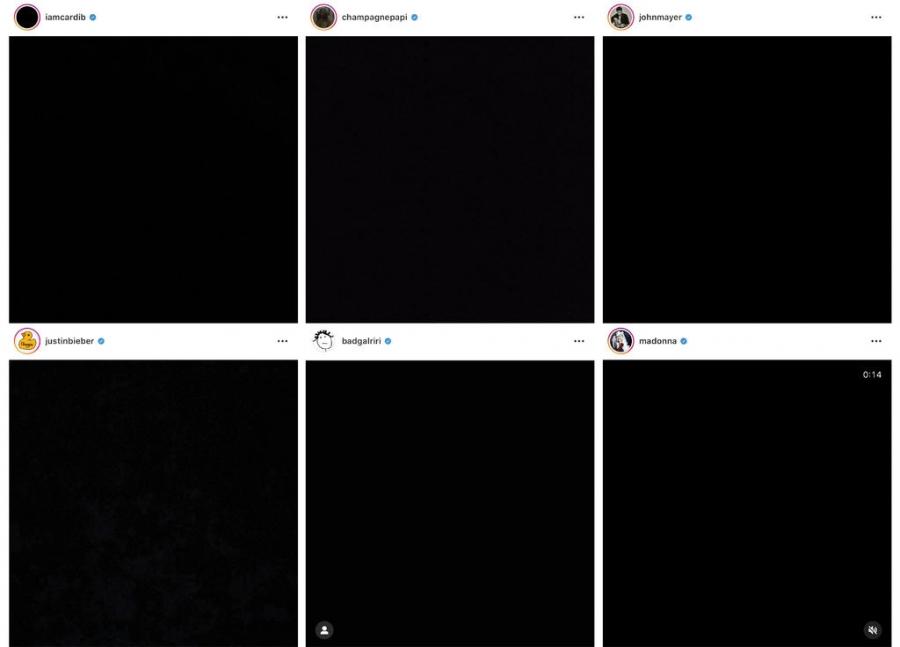
Celebrities showed their support for #BLM by posting black squares on Instagram
Since Floyd’s death had such a profound impact, it was impossible for American politicians to avoid the debate, especially during the run-up to the 2020 presidential elections.
In the next section, I will discuss how presidential candidate Joe Biden responded to George Floyd's death and the subsequent rise of the #BLM movement. I will analyze how Biden used the situation to win over Black voters during the run-up to the 2020 presidential elections through a discourse analysis of Biden’s tweets discussing George Floyd. Relevant information like the context of these tweets, Twitter as a medium, and Joe Biden as a sender will be thoroughly discussed as part of this analysis.
The 2020 presidential elections
The first point that I would like to address is the time frame relevant to this analysis. All tweets analyzed for this article were posted during the run-up to the 2020 presidential elections. The American elections are known for having a long period of campaigning. Although election day wasn’t until November 3rd, Floyd's death on May 25th took place when the battle for presidency was already in full swing.
Floyd's death resulted in a wave of protests, riots and debates on contemporary racism, and took over national as well as international mass media. Issues that dominate the news can directly impact voter appraisals of presidential candidates, as voters may approve or disapprove of the way they deal with public issues (DiCamillo, 2020). It was therefore very important for the 2020 presidential candidates to publicly proclaim how they felt about the situation.
Floyd's death took place when the battle for presidency was already in full swing.
This created an opportunity for Biden to win over voters. Although the debate on racism was difficult to initiate and could backfire, it could also result in a lot of votes from people of color if handled correctly. This was especially important for Biden, as the Black community tends to support Democratic candidates (Chatelain, 2020).
Motivating Black people to vote was even more essential as Black voter turnout had decreased over the past several elections (Chatelain, 2020). Therefore, Biden took the opportunity to motivate Black voters by showing his support for their community. He took a clear stance on his Twitter and publicly supported the #BLM movement, condemning systematic racism and demanding justice for Floyd.
The posts below represent how Biden clearly took a stance against racism and supported the #BLM movement. First, he openly shows his disapproval of excessive police violence and states he is grateful the Minneapolis police officers involved were fired. He calls their actions egregious and calls for a thorough FBI investigation. Moreover, he states that "it's long past time we reform policing."
Second, Biden shows his support for the #BLM movement. In a May 27th tweet, Biden refers to the movement by stating “His life mattered”. Lastly, he acknowledges and condemns contemporary racism.
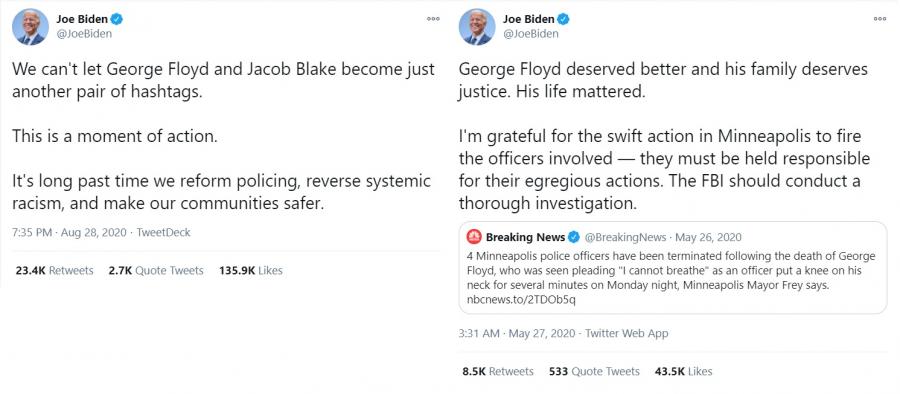
Joe Biden publicly showing his support for the black community
In addition to self-promoting by demonstrating his own support for the Black community, Biden also undermines his opponent, Donald Trump. In the tweet below, he expresses disgust for the way Trump spoke about Floyd during a speech. Biden emphasizes the impact that Floyd’s last words; “I can’t breathe” became a well-known slogan of the #BLM movement. In doing this, Biden not only aim to improve voter appraisals of himself, but simultaneously tries to negatively influence those of Trump.
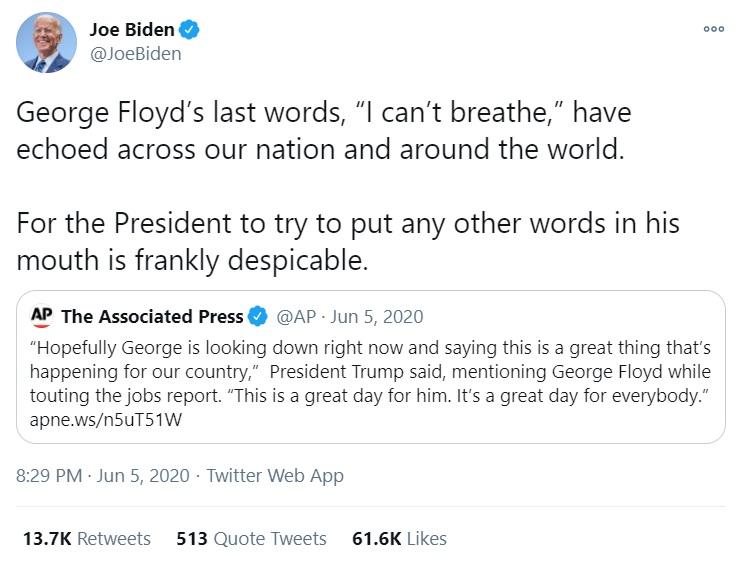
Biden disapproves of fellow presidential candidate Donald Trump
The medium shapes the message
The medium of communication, in this case Twitter, is also highly relevant to this analysis. Twitter has increasingly become a political battlefield (Blommaert, 2020). A growing number of politicians and political parties have decided to step into the world of social media. But what is their motivation? Research has found that both marketing and dialogue with voters are important motives for political social media use (Enli & Skogerbø, 2013). Politicians’ tweets often include links to articles or interviews about themselves, self-promoting rather than providing political insight (Parmelee & Bichard, 2011).
Biden self-promotes through linking to interviews as well, as seen in the tweets below. Biden posted four tweets in which he addresses Floyd’s death and links to his statement on the topic. He accompanies these videos with captions: “Tune in as I address the unfolding situation in Minnesota and the killing of George Floyd.” Talk and image mutually enhance each other, and videos like these can complement the statements that Biden makes in his tweets (Goodwin, 1994). This is even more interesting given that Twitter's affordances only allow for 140 characters per tweet.
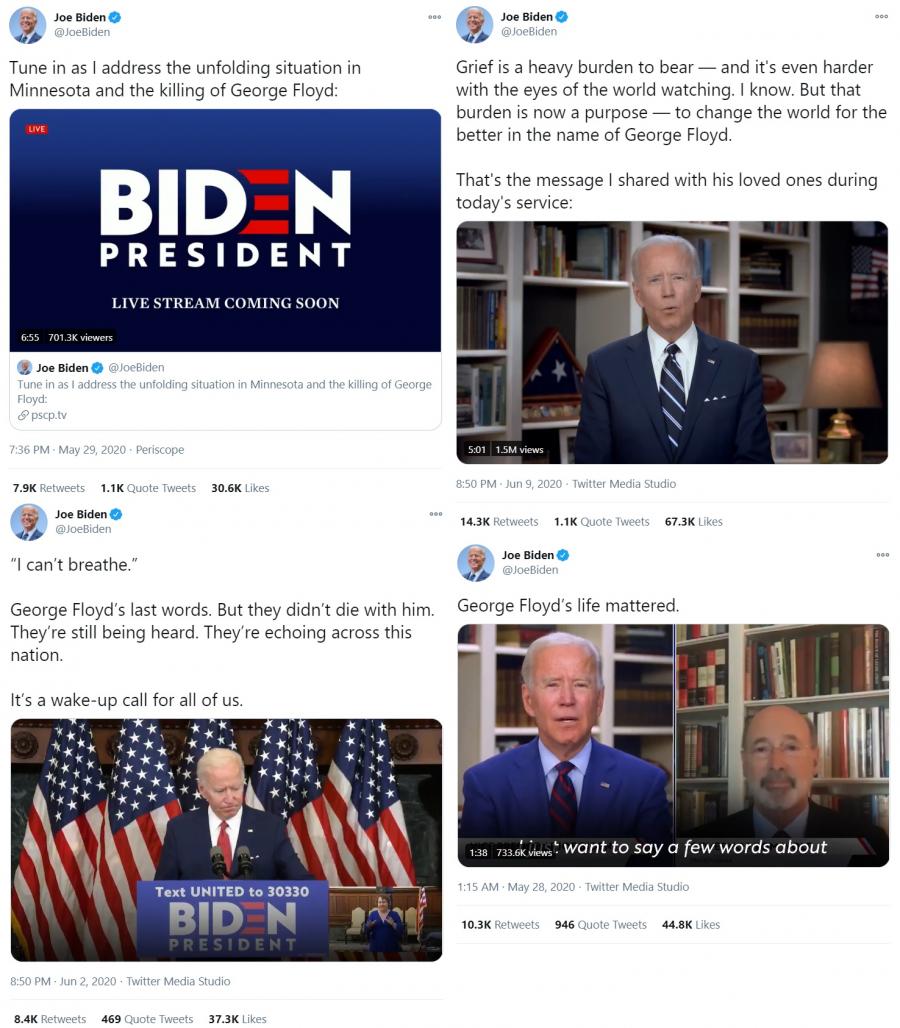
Biden complements his statements with speeches
Not only has Biden used material representations of himself to invigorate his tweets, he has also included a video of Floyd’s family. In this video, Floyd’s brother reminisces on how loving his brother was and how he and other victims of white police brutality should be alive today. Biden accompanies this video with an affirmative statement in which he acknowledges Floyd’s “giving spirit” and the belief that he should still be alive. By using this video in his tweets, he creates a sense of connectedness with the Black community. Moreover, the video is emotionally appealing as it involves Floyd’s brothers who have just lost a loving family member.
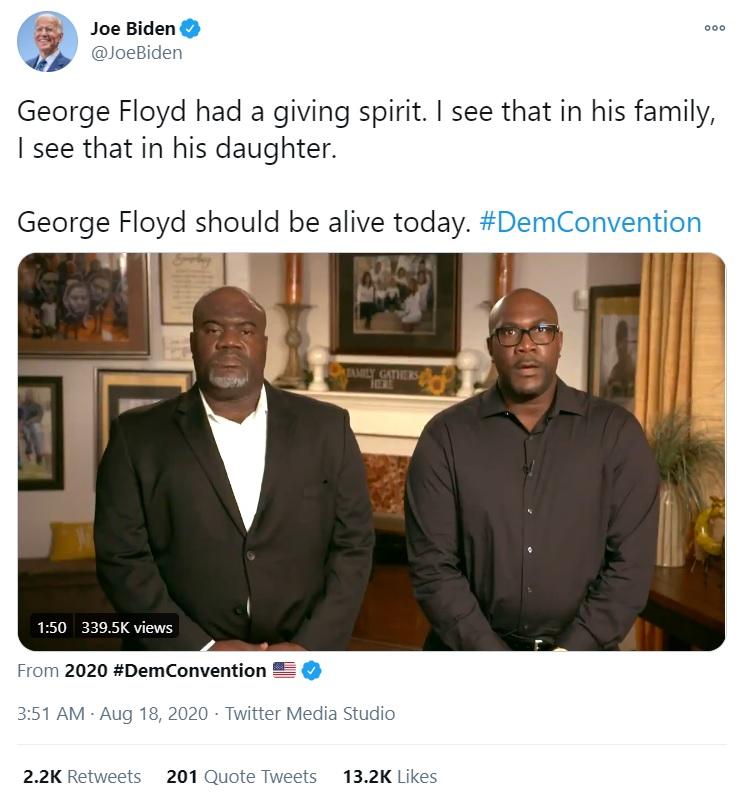
Biden provides a stage for Floyd's family to share their thoughts
Discursive practices: invigorating statements
Moving forward, I want to focus on the actual language in Biden’s tweets. In his tweets, multiple discursive practices can be found like coding, highlighting, and metaphors. First, Biden codes the death of Floyd as a murder by saying “… the killing of George Floyd.” By classifying Floyd’s death as a murder, he directly accuses the police officers involved.
He backs up this statement by stating “we need real police reform to ensure this never occurs again”, “I’m grateful for the swift action in Minneapolis to fire the officers involved,” and “It’s a long time past we reform policing” in other tweets. By coding the death of Floyd as a killing and judging the police officer’s actions, Biden publicly acknowledges that the police violence was unjustifiable. This may have a far-reaching impact, as coding Floyd’s death as a murder organizes people’s perception of the event (Goodwin, 1994).
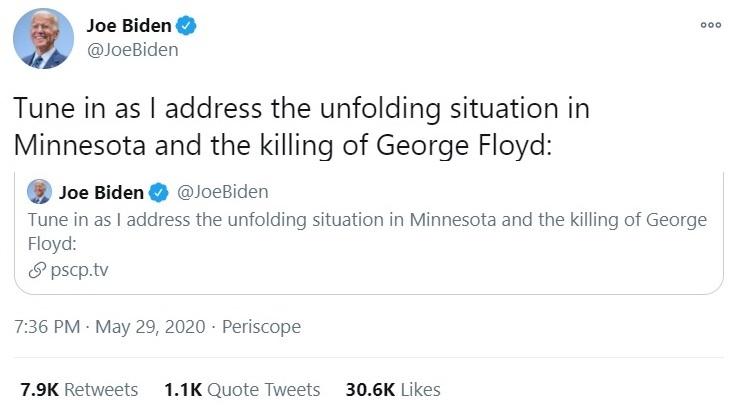
Biden publicly labels the death of Floyd as a killing
Second, it is striking how often Biden highlights that victims of police brutality should not be forgotten. By including the names of Breonna Taylor and Jacob Blake, he bolsters this statement by showing that police violence is an extensive problem with numerous victims. In multiple tweets, Biden refers to the importance of taking swift action, stating, “We can’t let George Floyd become just another pair of hashtags.” With this metaphor, Biden implies that more action is needed than merely raising awareness on social media. It requires more than just some hashtags to dismantle systematic racism. “This is a moment of action”, Biden states.
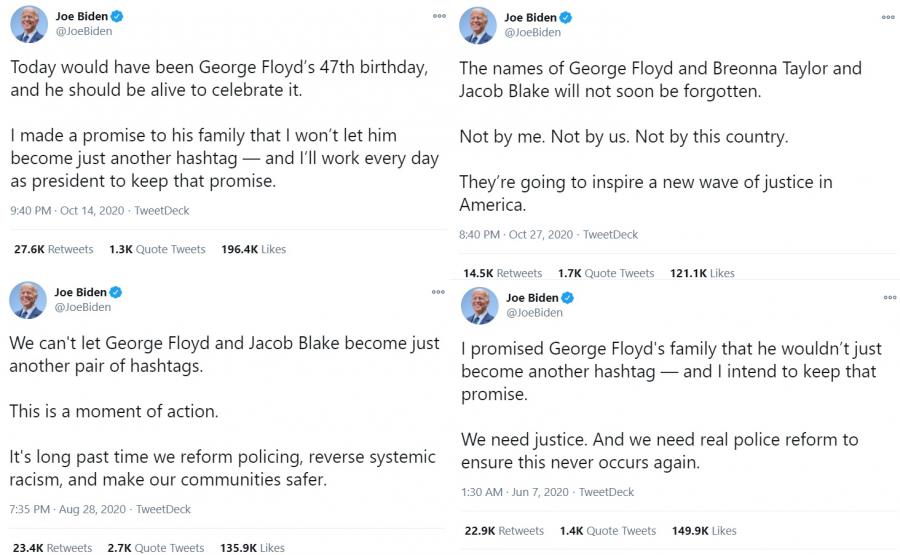
Biden emphasizes that the deaths of George Floyd, Breonna Taylor and Jacob Blake should instigate a new wave of justice
Third, Biden metaphorically refers to racism in America in a May 30th tweet. He says “It’s time for us to take a hard look at uncomfortable truths. It’s time for us to face the deep, open wound we have in this nation.” Although he does not specifically mention racism, his closing sentence “We need justice for George Floyd” gives it all away. The uncomfortable truth and the deep, open wound that Biden refers to is structural racism. He implies that, although it is uncomfortable and painful, the problem needs to be faced and solved in order to serve justice. This shows Biden’s followers that he is not afraid to face difficult problems.
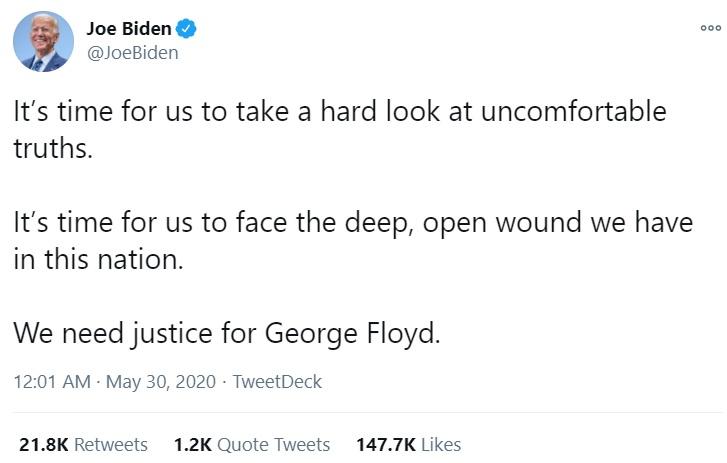
According to Biden, racism is a deep, open wound that America should face and solve.
There is one final tweet that I would like to address, below. Biden’s makes a clear distinction between the “black reporter” and the “white police officer”. By including the words black and white, he emphasizes the importance of skin color in this context. He implies the Black reporter's innocence by adding “while doing his job,” followed by a contrasting accusation of the white police officer. The word choice in this tweet clearly shows that he supports the Black reporter and condemns the white police officer.
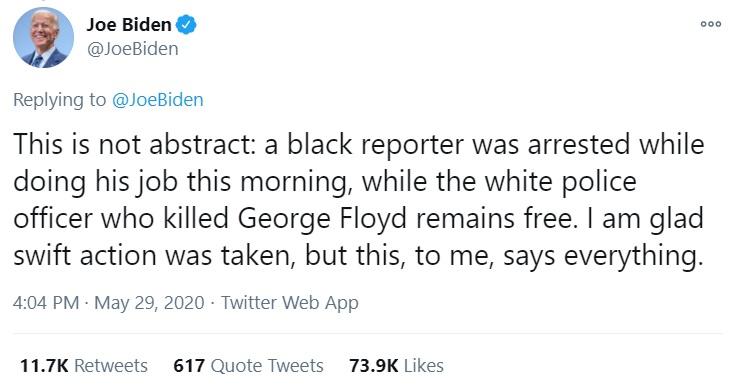
A clear emphasis is placed on the importance of skin color by Biden
Joe Biden: power through authority
Before drawing any conclusions, it is important to keep in mind that the sender of a message can influence its effect. As Biden has been a senator since 1973 and served as vice-president during the Obama administration, he is a public figure with political authority in America. According to Becker (1967) this gives Biden the power to define things, as he has a prominent position in the hierarchy of credibility.
This hierarchy of credibility refers to a system of ranked groups, in which members of the highest groups have the right to define, shape and classify things and people (Becker, 1967). Anything from those at the top of the hierarchy is generally regarded as credible by those of lower ranks. Therefore, Biden’s tweets will be regarded as credible by those who have accepted this established order (Becker, 1967). As a result, Biden can be extremely important in the establishment of a new normality in which racism does not belong. By communicating his ideas and beliefs, he can significantly influence those of others.
Biden can be extremely important in the establishment of a new normality in which racism does not belong.
This idea is supported by the belief that a great deal of power and social control is not exercised by physical force but rather by experts who are accepted as defining, describing, and classifying things and people (Camron, 2001). The practice of defining, describing and classifying is carried out by using language, for instance on social media. To conclude, Biden has the power to influence others' beliefs due to his political authority and prominent position in American society. The messages that he distributes will be picked up by a large audience and can be highly influential in debates on the construction of society and racism.
Was Biden's strategy successfull?
This article investigated how Joe Biden used George Floyd's death and the consecutive rise of the #BLM movement to win over Black voters. Floyd’s death led to a wave of protests and riots and instigated a debate on contemporary racism. During the run-up to the 2020 presidential elections, this was a topic that could not be ignored by candidates. For Biden, this situation came with opportunities to win over Black voters by showing support for their community.
This discourse analysis has demonstrated that Biden clearly took a stance against racism by strongly supporting the black community in his tweets about George Floyd. He did this by condemning excessive police violence, acknowledging structural racism, and calling for action. In some cases, he complemented these statements with material representations or invigorated them with discursive practices. These statements can be highly influential in the public debate on racism, as Biden is a public figure with political authority. Biden's opinions and beliefs may be of great importance in the construction of a new normality in which there is no space for racism.
You might wonder if all this helped Biden in his battle for presidency. Well, after days of counting votes, Biden was finally elected as president of the United States on November 7th. Biden broke the record by receiving more than 81 million votes. More relevant to this article, Biden received 87% of votes from Black voters, Trump received only 12% (Molyneux, 2020). In total, Biden received even more votes from Black Americans than Barack Obama received when he was first elected. Moreover, the Black voter turnout was higher than the 2016 elections (Stafford, Morrison & Kastanis, 2020). Biden has clearly won the trust of Black Americans to fight racism together with them. Now all that remains for us is to wait and hope that Biden uses his newly acquired position to add actions to his words.
References
Balibar, E. (2007). Is there a 'neo-racism'?. Race and racialization: Essential readings, 83.
Becker, H. S. (1967). Whose side are we on?. Social problems, 14(3), 239-247.
Blommaert, J. (January 14, 2020). Twitter politics: the next stage. Diggit Magazine.
Cameron, D. (2001). Working with spoken discourse. London, England: SAGE.
Chatelain, M. (2020). Diversity and the Democrats. Dissent, 67(3), 52-57.
DiCamillo, M. (2020). Release #2020-11: California voters overwhelmingly prefer Biden to Trump in the November presidential election.
Eltis, D. (2008). Extending the Frontiers: Essays on the New Transatlantic Slave Trade Database. Yale University Press.
Enli, G. S., & Skogerbø, E. (2013). Personalized campaigns in party-centred politics: Twitter and Facebook as arenas for political communication. Information, communication & society, 16(5), 757-774.
Goodwin, C. (1994). Professional vision. American anthropologist, 96(3), 606-633.
Greer, C., & McLaughlin, E. (2010). We predict a riot? Public order policing, new media environments and the rise of the citizen journalist. The British Journal of Criminology, 50(6), 1041-1059.
Molyneux, J. (2020). The fall of Trump. Irish Marxist Review, 9(28), 3-4.
Parmelee, J. H., & Bichard, S. L. (2011). Politics and the Twitter revolution: How tweets influence the relationship between political leaders and the public. Lexington Books.
Stafford, K., Morrison, A., Kastanis, A. (November 9, 2020). ‘This is proof’: Biden's win reveals power of Black voters. AP News.
Trottier, D. (2017). Digital vigilantism as weaponisation of visibility. Philosophy & Technology, 30(1), 55-72.
Wood, P. (2003). "The Birth of Race-Based Slavery". Reprinted from "Strange New Land: Africans in Colonial America". Oxford University Press.